|
 |
|
Published
by : PROFESSIONAL MEDICAL PUBLICATIONS |
|
ISSN 1681-715X |
|
|
|
- |
|
ORIGINAL
ARTICLE |
|
- |
|
Volume 25 |
October - December 2009
(Part-II) |
Number
6 |
|
|
|
Characterization of shallot, an antimicrobial
extract of allium ascalonicum
Mansour Amin1, Effat Abasi Montazeri2,
Mohammad Ali Mashhadizadeh3, Ahmad Farajzadeh Sheikh4
ABSTRACT
Objective: The objective of this
study was characterization of antimicrobial extract of shallot in terms of its
stability at different pH, Heat, enzymes and detergents and also determination
of its MIC and shelf life.
Methodology: Active fraction was
determined by column chromatography and agar diffusion test. The amount of
carbohydrate and protein in different forms of shallot extract were estimated.
Stability of antimicrobial activity of shallot extract at different pH and
temperature, solubility in different solvent, determination of shelf life and
susceptibility to enzymes and detergents were evaluated.
Results: Shallot extract was active
against microbes at pH 4-8. Relative activities of shallot extract at
temperature –7 to 121°C were 88 to 100 %. Extract of shallot only was soluble
in dimethyl sulphoxide, dimethyl formamide and water. The enzymes and
detergents used in this study had no effect on antimicrobial activity on water
extract of shallot. Relative antimicrobial activity at incubation times of one
hour to6 mounts were 94 to 100 %.
Conclusion: In this study antimicrobial
properties of shallot were investigated for discovery of a new antibiotic.
Based on this the antimicrobial compound can be an effective medicine for
treatment of dermatomycosis and other infectious diseases.
KEY WORDS:
Allium ascalonicum, antimicrobial,
MIC, characterization.
Pak J Med Sci October - December
2009 (Part-II) Vol. 25 No. 6 948-952
How to cite this article:
Amin M, Montazeri EA, Mashhadizadeh MA, Sheikh AF.
Characterization of shallot, an antimicrobial extract of allium ascalonicum.
Pak J Med Sci 2009;25(6):948-952.
1. Mansour Amin.
2. Effat Abasi Montazeri.
3. Mohammad Ali Mashhadizadeh.
4. Ahmad Farajzadeh Sheikh.
1-4. Department of Microbiology,
School of Medicine,
Ahwaz Jondishapour University of Medical Sciences,
Ahwaz – Iran.
Correspondence:
Dr. Mansour Amin
Department of Microbiology,
School of Medicine,
Ahwaz Jondishapour University of Medical Sciences,
Ahwaz – Iran.
E.mail: mnsamin@yahoo.com
* Received for Publication: December 26, 208
* Revision Received: September 9, 2009
* Accepted Date: September 16, 2009
INTRODUCTION
Due to emergence of resistance among microorganisms to
antibiotics, investigation for novel antimicrobial agents has always been one
of the major preoccupations of medical society. Spices and herbs have been
used for thousands of centuries by many cultures to enhance the flavor and
aroma of foods. Early cultures also recognized the value of using spices and
herbs in preserving foods and for their medicinal value. Scientific
experiments since late 19
th
century have documented the antimicrobial properties of some spices, herbs,
and their components.1,2
Studies in the past decade confirm that the growth of both gram positive and
gram negative foodborne bacteria, yeasts and molds can be inhibited by garlic,
onion, cinammon, cloves, thyme, sage, and other spices. Effects of the
presence of these spices/ herbs can be seen in food products such as pickles,
bread, rice and meat products. The fat, protein, water, and salt content of
food, influence the microbial resistance. Thus, it is observed that higher
levels of spices are necessary to inhibit growth in food than in culture
media.1
Present study is first report of the characterization of
antimicrobial extract of Allium ascalonicum (shallot). Shallot is a
member of family Liliaceae. The genus Allium consists of more than three
hundred different species
3,
but only two species, Allium sativum (garlic) and Allium cepa
(onion), are well-known remedies in the prevention and treatment of different
diseases.4,5
Shallot is a native of Palestine and is cultivated in USA
and some European countries. It is commonly used as a folk-lore medicine, and
used to cure earache, fever, antidote for snake venom and also as an
aphrodisiac.
6
In our last study the antimicrobial activity of shallot extract had been
investigated. Most of the fungi were relatively more sensitive than bacteria
to extract of shallot. No obvious differences between the sensitivity of gram
negative and gram positive bacteria, yeasts and filamentous fungi, were
observed.7
Although, these findings are in contrast
with the results reported by Dankert et al8
who found that crude juice of shallot has no activity against gram negative
bacteria. The objective of this study was characterization of antimicrobial
extract of shallot in terms of its stability at different pH, Heat, enzymes
and detergents and also determination of its MIC and shelf life.
METHODOLGY
Extraction of antimicrobial water extract from shallot:
The water extracts of underground bulbs of shallot was prepared by suspending
200g bulbs of shallot in 100ml distilled water and homogenized in mixer. After
five hours, the extracts were filtered through whatman number one filter
paper. The filtrate of extract was dried at 50ºC in oven, redissolved in water
and used for column chromatography.
Fractionation of shallot extract by silica gel column
chromatography: For establishment of column chromatography, suspension of
10 gram silica gel (60-120 mesh) in 100ml of distilled water and ethanol
(50:50) was prepared and it was slowly poured and packed in a glass column.
The diameter and height of the tube were 2cm and 35cm respectively. A small
piece of glass wool was used in the bottom of the tube to support the silica.
2 ml of water extract of shallot (500mg ml
-1)
was used for loading the column. As soon as the sample passes through the
column, the particular solute was removed by amount of solvent (distilled
water and ethanol) from the column.9
The flow rate was 1 ml per 30 minutes. 40 fractions of one ml were collected
in small glass tubes. An agar diffusion assay was used for evaluating
antimicrobial activity of all fractions against Bacillus cereus.
Determination of minimal inhibitory concentration by E
test: The E test has been proved to be remarkably flexible method for
determining MIC of a wide range of antimicrobial agents.
10
Microbial suspensions of freshly grown cultures were prepared in sterile
saline and adjusted to a density of 106
spore /cell ml-1,
corresponding to 68 to 82 % transmittance at 530 nm.11
The plates, Sabouraud Dextrose Agar, Hi Media, (SDA) for fungi and Mueller
Hinton Agar, Hi Media (MHA) for bacteria were inoculated by dipping a sterile
cotton swab into the cell suspension and streaking it across the surface of
the agar in three directions. The plates were dried at ambient temperature for
15 minutes before applying the discs. Eight sterile discs (diameter 6 mm) were
kept on the agar surface in a line. The water extract of shallot was serially
diluted in water; and10 µl of each dilution was separately used to impregnate
the disc. The plates were incubated for 48 hours at 28º C for A. niger
and Trichophyton rubrum and 18 hours at 37º C for others. The MIC
values were read as the antimicrobial concentration at the point where dense
colonial growth intersected the disc, ignoring sparse subsurface hyphae at the
margins. Microcolonies within the eclipse were ignored.12
The test was performed in quadruplicate for each culture.
Stability of antimicrobial activity of water extract of
shallot at different pH: Antimicrobial activity of water extract of
shallot was evaluated at different pH values, by diffusion test. The pH of the
extract was varied, using the following buffers: acetate buffer (pH4.0, 5.0)
phosphate buffer (pH6.0, 7.0, 8.0), tris - hydrochloride buffer (9.0) and
carbonate – bicarbonate buffer (pH 10.0).
13
The pH stability of the extract was evaluated by agar diffusion testing on MHA
media against Bacillus cereus. 0.5 ml of extract (200 mg ml-1)
was added in the tubes containing
0.5 ml of different buffers.13
After 1hour incubation at 37°C, 20 m l was impregnate in blank disc on MHA.
Heat stability of antimicrobial activity of water extract
of shallot: The effect of temperature on extract of shallot in liquid form
was determined by agar diffusion test. 20 mg ml
-1concentration
of shallot extract was prepared and divided into 5 tubes. The tubes were
incubated at -7°C for24 h, 4° C for 24 h, 22° C for 24 h, 100° C for 30
minutes. and 121° C for 20 minutes. Then 10 ml of each tube was impregnated in
blank discs on MHA that previously seeded with Bacillus cereus.
Susceptibility of water extract of shallot to enzymes and
detergents: Susceptibility to denaturation by detergents and enzymes was
studied by treating the shallot extract with cetrimide, tween-20, tween-80,
sodium dodecyl sulphate, triton x-100 and sodium lauryl sulphate as detergents
and trypsin, pepsin, lipase, and amylase as enzymes. One ml of detergents was
added to shallot extract at concentrations of 10
-2
M of detergent ml-1
shallot extract containing 200 mg dried extract ml-1
distilled water. These preparations were incubated at 30°C for six hour and
tested for antimicrobial activity.14The
diffusion test was used as described previously. A water solution of extract
of shallot was used as control.
Determination of shelf life of shallot extract: The
effect of incubation time on antimicrobial activity of water extract of
shallot was determined by keeping the extract at 4° C in different tubes, for
1 hour, 24 hour, one week, one month, two month, three month and six month.
After specified incubation period, the antimicrobial activity of the extract
was tested by disc diffusion against B. subtilis. All experiments
mentioned above were performed in four folds.
RESULTS
Minimal inhibitory concentration of water extract of
shallot by E test: Susceptibility of seven microorganisms to water extract
of shallot was determined by E test. All microorganisms tested were sensitive
to the shallot extracts. B. subtilis was more sensitive to extract than
others (MIC 38µg ml
-1)
(Table-I).
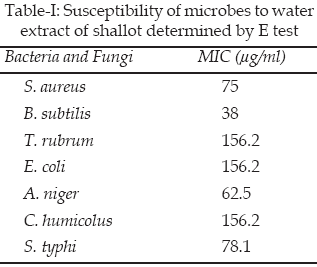
Antimicrobial activity and purity of silica gel column
fractions: All the fractions obtained by column were tested by disk
diffusion assay. The fractions 12-15 showed more activity than others. TLC was
performed for checking the purity of bioactive fractions. All the four
antimicrobial active fractions showed single spot on TLC plate at similar
locations (Rf was 0.80), which were developed by iodine. No spots were
detected by ninhydrin.
Stability at different pH: Antimicrobial activity of
extract of shallot was stable at different pH ranging from 4 to 8. But at high
alkaline pH (9-11) the stability was reduced. The diameter of inhibition zone
at pH 4 was 15 mm, at pH 7 was 17mm and at pH 11 was 8 (Table-II).
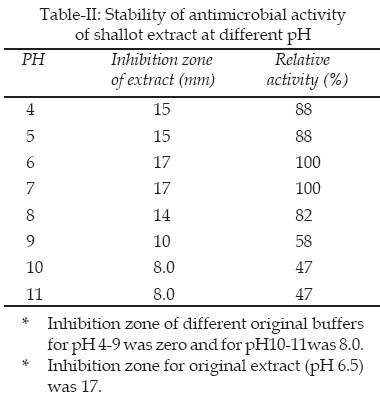
Stability of shallot extract at different temperatures:
The extract of shallot was stable at different
temperatures. There was no difference between diameters of inhibition zones
caused by autoclaved and frozen (15mm) water extract of shallot (Table-III).
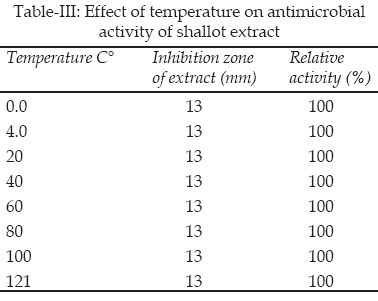
Susceptibility to enzymes and detergents: The enzymes
and detergents used in this study had no effect on antimicrobial activity on
water extract of shallot. There was no significant difference between
inhibition zone of control (water extract of shallot) and extract treated with
enzymes and detergents (Table-IV).
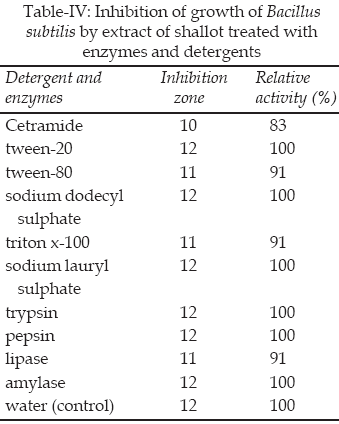
Determination of shelf life of shallot extract: The
antimicrobial activity of the shallot extract was stable at 4º c for 1 h till
6 months (Table-V).
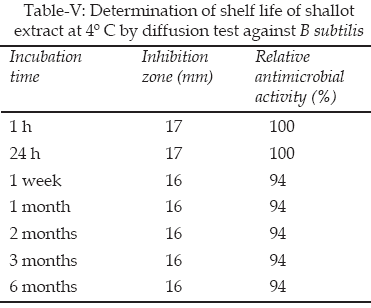
DISCUSSION
To our knowledge there have been few reports detailing the
investigation of antimicrobial compound in shallot bulbs. Wang and Ng (2002)
isolated an anti-fungal peptide from bulbs of shallot. This peptide inhibited
mycelial growth in the fungus Botrytis cinerea but not in the fungi
Mycosphaerella arachidicola and Fusarium oxysporum.
15
Dankert et al
8
have evaluated the antimicrobial
activity of garlic, onion and shallot using crude juices of bulbs of these
plants. Fattorusso et al16
also have done an extensive
phytochemical analysis on the polar extracts from bulbs of shallot. These
researchers isolated two new furostanol saponins but there is no antimicrobial
investigation in their report. Mo et al17
have isolated a new mannose-binding lectin from shallot bulbs by affinity
chromatography on an immobilized D-mannose column. In this investigation there
was no antimicrobial study done on the new lectin.
Regarding great antimicrobial activity of shallot extract
against wide spectrum of pathogenic and non-pathogenic microorganisms, water
was a good solvent that isolated a maximum amount of antimicrobial compound
from fresh shallot bulbs.
Antimicrobial compound of water extract of shallot was very
heat stable and active over a wide range of pH. Antimicrobial principle of
shallot was resistance to and active under both acid pH and basic pH.
Different temperatures did not show significant effect on antimicrobial
activity of shallot extract. These results increase the chance of utilization
of shallot extract as a natural preservative at different temperatures from
–7C – 121C. However garlic has been reported for using as a natural
preservative in camel meat
18,
but the instability of garlic products is a problem in this way.
Proteolytic enzymes such as trypsin and pepsin did not
destroy the antimicrobial activity of shallot extract. These results prove
that the active fraction of this plant is not a protein. Treatment with lipase
also did not cause any loss in antimicrobial activity, probably because of the
absence of lipid moieties in the principle of antimicrobial agent. It seems
that shallot extract can be used as a prophylactic antimicrobial agent.
In conclusion the shallot extract is a powerful
antimicrobial agent and is stable at different pH, temperatures, enzymes and
detergents. It suggested using this extract as a food preservative and local
ointment for skin infections.
REFERENCES
1. Shelef, L A Antimicrobial effects of
spices. J Food Safety 1983;6:29-44.
2. Zaika, LL.Spices and herbs, their
antibacterial activity and its determination. J Food Safety 1988;9:97-118.
3. Steinegger E, Hansel R.Lehrbuch der
pharmakognosie, 2nd ed 1968 Pp.404-407 Springer-Verlag, Berlin.
4. Hagenow G. Die Bedeutung der
Kuchenzwiebel (Allium cepa L.)als Nahrung und Heilmittel im Altertum.
Erfahrung und Aberglaube. Qual. Plant.-Pl. Fds. Hum. Nutt 1974;24:163-173.
5. Petkov W. Pharmakologische und klinische
untersuchungen des knoblauchs. Dtsch Apoth.-Ztg 106(1966)1861-1867.
6. Ghosh GK. Herbs of Manipur, Aphpublishing
corporation, New Delhi, India, 2000 p: 1053.
7. M.Amin, B.P.Kapadnis. Heat stable anti
microbial activity of Allium ascalonicum against bacteria and fungi. Indian J
Experimental Biology. 2005;43:751-754.
8. Dankert J, Tromp ThF.J, Devries H, Klasen
HJ Antimicrobial activity of crude juices of Allium ascalonicum, Allium cepa
and Allium sativum. Zb Bkr Hyg I Abt Orig 1979;A245:229-239.
9. Boyer R. Modern experimental
biochemistry. Third edition, Benjamin Cummings 2001;P:70-73.
10. Prescott LM, Harley JP, Klein DA.
Microbiology. Mc Graw Hill, New York. 16th. Ed. 2005;p:780-798.
11. Pfaller MA, Messer SA, Aring Karlsson
Bolmstvom A. Evaluation of the E test method for determining fluconazole
susceptibilities of 402 clinical yeast isolates by using three different agar
media. J Clin Microbio 1998l;36:2586-2589.
12. Pfaller MA, Messer SA, Mills K,
Bolmstrom A. In vitro susceptibility testing of filamentous fungi: comparison
of E test and reference microdilution method for determining itraconazole MICs.
J Clin Microbiol 2000;38:3359-3361.
13. Smibert RM, Krieg NR. Phenotypic
characterizations. In Gerhard t. p. Murray R.G.E., Wood W.A, Krieg N.R. (eds.)
Methods for general and molecular bacteriology. American Society for
microbiology Washington D.C.USA. 1994.
14. Munimbazi C, Bullerman LB. Isolation and
characterization of antifungal metabolites of Bacillus pumilus. J Applied
Microbiology 1997;84:959-968.
15. Wang HX, Ng TB. Ascalin. A new
anti-fungal peptide with human immunodeficiency virus type 1 reverse
transcriptase-inhibiting activity from shallot bulbs Peptide.2002;
23:1025-1029.
16. Fattorusso E, Iorizzi M, Lanzotti V,
Taglialatela- Scafati O. Chemical Composition of Shallot (Allium ascalonicum
Hort.). J Agric Food Chem 2002;50:5686-5690.
17. Mo H, Van Damme EJ, Peumans WJ,
Goldstein IJ. Purification and Characterization of a mannose-specific lectin
from shallot (Allium ascalonicum) bulbs. Arch Biochem Biophys
1993;306:431-438.
18. Al-Delaimy K S, Barakat MMF. Antimicrobial and
preservative activity of garlic on fresh ground camel meat. I. Effect of fresh
ground garlic segments, J Sci Food Agric1971;22,96-98.
HOME
| SEARCH
| CURRENT
ISSUE | PAST
ISSUES
Professional
Medical Publications
Room No. 522, 5th Floor, Panorama Centre
Building No. 2, P.O. Box 8766, Saddar, Karachi - Pakistan.
Phones : 5688791, 5689285 Fax : 5689860
pjms@pjms.com.pk





